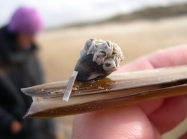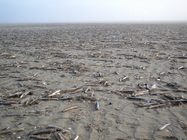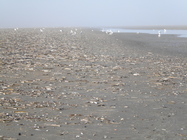
| Intro | | Search taxa | | Browse taxa | | Distributions | | Terminology | | References | | Statistics | | Online sources | | Tutorial | | Log in |
MolluscaBase name detailsEnsis americanus (A. Gould, 1870)
152356 (urn:lsid:marinespecies.org:taxname:152356)
unaccepted > junior subjective synonym
Species
marine,
(of Solen ensis var. americanus A. Gould, 1870) Gould, A. A. (1870). <i>Report on the Invertebrata of Massachusetts</i>. Second edition, comprising the Mollusca. Edited by W.G. Binney. Wright and Potter, Boston, v + 524 pp., pls. 16–27. , available online at https://www.biodiversitylibrary.org/page/10897088
page(s): 42 [details]
MolluscaBase eds. (2025). MolluscaBase. Ensis americanus (A. Gould, 1870). Accessed at: https://molluscabase.org/aphia.php?p=taxdetails&id=152356 on 2025-07-17
Date action by
original description
(of Solen ensis var. americanus A. Gould, 1870) Gould, A. A. (1870). <i>Report on the Invertebrata of Massachusetts</i>. Second edition, comprising the Mollusca. Edited by W.G. Binney. Wright and Potter, Boston, v + 524 pp., pls. 16–27. , available online at https://www.biodiversitylibrary.org/page/10897088
page(s): 42 [details] context source (Introduced species) Molnar, J.L., R.L. Gamboa, C. Revenga & M.D. Spalding. (2008). Assessing the global threat of invasive species to marine biodiversity. <em>Frontiers in Ecology and the Environment.</em> 6(9): 485-492., available online at https://www.conservationgateway.org/ConservationPractices/Marine/Pages/marineinvasives.aspx [details] Available for editors basis of record de Kluijver, M. J.; Ingalsuo, S. S.; de Bruyne, R. H. (2000). Macrobenthos of the North Sea [CD-ROM]: 1. Keys to Mollusca and Brachiopoda. <em>World Biodiversity Database CD-ROM Series. Expert Center for Taxonomic Identification (ETI): Amsterdam, The Netherlands. ISBN 3-540-14706-3. 1 cd-rom.</em> (look up in IMIS) [details] additional source Streftaris, N., A. Zenetos & E. Papathanassiou. (2005). Globalisation in marine ecosystems: the story of non-indigenous marine species across European seas. <em>Oceanogry and Marine Biology: an Annual Review.</em> 43: 419-453. (look up in IMIS) [details] Available for editors source of synonymy Cosel R. von, 2009. The razor shells of the eastern Atlantic, part 2. Pharidae II: the genus <i>Ensis</i> Schumacher, 1817 (Bivalvia, Solenoidea). <i>Basteria</i>, 73: 9-56 , available online at http://natuurtijdschriften.nl/download?type=document&docid=597354 [details]  Present Present  Inaccurate Inaccurate  Introduced: alien Introduced: alien  Containing type locality Containing type locality
From regional or thematic species database
Introduced species population trend in North Sea (IHO Sea Area) : Increasing [details]Introduced species population trend in Baltic Sea (IHO Sea Area) : Increasing [details] Introduced species population trend in Celtic Sea (IHO Sea Area) : Increasing [details] Introduced species vector dispersal in North Sea (IHO Sea Area) : Perhaps introduced to Europe as larvae in tanker ballast water; its spread within European waters has been natural larval dispersal. [details] Introduced species vector dispersal in Baltic Sea (IHO Sea Area) : Perhaps introduced to Europe as larvae in tanker ballast water; its spread within European waters has been natural larval dispersal. [details] Introduced species vector dispersal in Celtic Sea (IHO Sea Area) : Perhaps introduced to Europe as larvae in tanker ballast water; its spread within European waters has been natural larval dispersal. [details] Introduced species vector dispersal in Celtic Sea (IHO Sea Area) : Perhaps introduced to Europe as larvae in tanker ballast water; its spread within European waters has been natural larval dispersal. [details] Unreviewed
Synonymy According to some authors (e.g. van Urk, 1987), E. americanus (Gould, 1870) is a valid species, distinct from E. directus (Conrad, 1843). [details]
|



